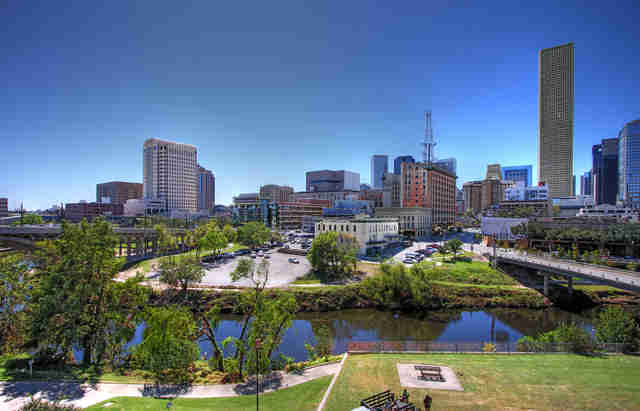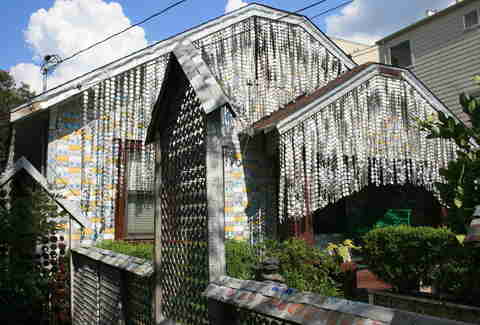Unintended Benefits of Houston Being America's Worst-Designed City
By BROOKE VIGGIANOPublished On 03/23/2016

So it turns out we may be America’s worst-designed city. Lack of “official” zoning. Messy roads and meager public transportation options. Complete chaos. We get it, our predecessors sucked at design. But that may not necessarily be a bad thing. In fact, there are a bunch of ways in which the city totally (and unintentionally) came out ahead in the whole “the plan is there is no plan” deal.

Flickr/Sandra Fernandez
1. It may have saved us from the housing market crash
Love it or hate it, Houston’s lack of zoning may actually be what shielded it from the popped housing bubble that rocked the rest of the country. Picture Margot Robbie explaining this all whilst in a bubble bath drinking champagne. While housing prices soared as the national bubble inflated, Houston’s costs remained modest; and when all hell broke loose when the bubble burst, H-town remained largely unaffected.
As discussed in an article from the Chron, senior economist Bill Gilmer found that zoning regulations were partly to blame. First, the laws constricted supply, which resulted in raising the cost of new home construction. As housing demand increased, cities with strict zoning laws saw prices increase due to the lack of supply. In turn, the high housing prices extinguished demand and - BOOM - the mortgage market collapsed and chaos consumed the majority of the country -- minus Houston, where the increase in demand was met with an increase in construction/supply. Or something like that. Whatever. Margot Robbie in a ubble bath.

Flickr/telwink
2. We have, like, five different Downtowns
Most cities have one Downtown. That’s pretty cool and all, but you know what’s cooler? Having five times the amount of business and social epicenters that other cities have. Actual “Downtown” is pretty sweet for starters, and then we have hotbeds like Uptown and the Galleria, Greenway Plaza, the Med Center, and the Woodlands for damn sake.

Flickr/Noel Hankamer
3. Where else would a HOUSE MADE OF BEER CANS exist?
Nowhere. The answer is clearly nowhere. Urban planning website Next City even published a piece entitled “Seven Buildings (and Neighborhoods) That Would Never Fly in Any City But Houston,” in which our lack of planning is shown to have spawned some pretty neat developments in areas where, in other cities, “builders wouldn’t even think of poking the NIMBY hornet’s nest.”

Flickr/Planetgordon.com
4. Thirty extra minutes of traffic means 30 extra minutes of quality podcast time
Listen, in a city where urban sprawl runs rampant and you have more than 2 million people trying to make their way around, road congestion is inevitable. But look on the bright side of your prolonged commute: you have an extra half hour to finish the latest Serial episode (still a thing?) or gain a competitive advantage in your family fantasy football league.
related

The Seven Wonders of Houston

Flickr/brando.n
5. It proves democracy is alive and kicking
Do you know how many times we, as a people, shut down the city’s zoning proposals? Three. Three separate times: 1948, 1962, and 1993. All three times, the Houston community got together and was like, “Hey, how do y’all feel about zoning? We don’t need none of that crap, right?” And everyone was like, “Yeah! We’re going to vote this down even though the rest of America thinks it’s a good idea. Bless their hearts!”

Flickr/Daniel Horande
6. It promotes diversity
Having a taqueria next to a high rise that is next to an erotic boutique that is next to a strip mall with a banh mi shop may not look pretty, but what it bolsters is pretty - and that’s diversity, the blending of cultures, and a general attitude where everybody gets along with his or her neighbors. Kinda like Mister Rogers’ Neighborhood, without all the horrid sweaters and creepy puppets.

Flickr/Kevin Trotman
7. We have the same look as plenty of other cities, but we get to keep our street cred
If you look at Houston’s urban landscape, it’s not unlike that of other Sun Belt cities. Take Dallas, for instance. Are we really that different? The answer is no, and the reason is that we actually do have regulations in place that pretty much do the same thing as “official” zoning laws. Those regulations include things like limits on building sizes and heights, deed restrictions on the percentage of a lot that can be occupied, and regulations on the density of communities. All of this without losing one bit of our badass cowboy charm.

Flickr/Robert Young
8. We're more flexible
Communities can band together to enact change, creating a sort of bottom-up de facto zoning situation that is a bit more flexible than traditional zoning regulations. In turn, we’re able to respond to changes in land use demands and tastes faster and more efficiently, whether that means businesses and residents teaming up to alter lot size permits, or districts voting to protect their look with a “historic” status. Then there’s these cool things called municipal management districts (MMDs), which allow local property owners to levy small taxes on businesses and multifamily residential properties to fund local improvements. Just look at the East End, where you’ll find what was once a dilapidated shipyard and warehouse district blossoming into a mixed-use area that’s home to residences, parks, an awesome craft brewery, and a soon-to-be vodka microdistillery.

Flickr/Thomas Hawk
9. You could potentially get a payout for an inconveniently placed building
Sometimes our lack of top-down regulation means there’s nothing you can do to stop that nuisance high-rise from popping up in your otherwise aesthetically pleasing neighborhood. While that’s pretty annoying, it just may lead to a windfall of cash monies, which was the case with the Ashby high-rise, where 20 homeowners who filed suit against the developer of the 21-story apartment tower were awarded $1.2 million in damages. Sure, their property values may have suffered, but a win’s a win!

Flickr/Jon Wiley
10. We kind of prove things don’t blow up when government backs off
Libertarians would love us. With the exception of royally screwing up the HERO vote back in November, we’re an anomaly -- a (for the most part) socially liberal city that has a longstanding propensity to limit government. What’s pretty cool is that this hasn’t blown up in our faces. Instead, it has created a remarkable situation in which land use is propelled by economic forces instead of mandatory zoning. Take that, Americuh!

Flickr/Mike Rastiello
11. We’re quirky and we like it
Say what you will, but you can’t argue against the fact that Houston is unique. Sure, it may not actually look so different than other cities, as we discussed above, but it is different. Houstonians can get pasta and chicken fried steak at restaurants operating out of old, converted houses; walk down the street to a hardware store and thrift shop, then grab coffee and a croissant bigger than your face at a coffee shop; or take in rad art at a row of restored shotgun houses overlooking skyscrapers. We’re not cookie cutter, and we’re totally cool with that.

Flickr/Katie Haugland
12. We’re “The City With No Limits”
Fact: we’re already the worst-designed city in America, so we can’t go anywhere but up. As it turns out, we are. Houston’s population is expected to double over the next two decades. Good thing we’re growing accordingly. The city is currently pursuing an initiative to add 80 miles of interconnecting hike and bicycle trails; the light rail is being expanded; and you just have to walk down the street (literally any street) to see new construction popping up. Not to mention Forbes predicted we would become America’s next great global city by 2023. So, America’s worst-designed city? Yeah. We’ll take it.
No comments:
Post a Comment